Charles Edward Ridges
Family
Charles (or Charley) Edward Ridges was born in Loddiswell, near Kingsbridge, in 1894. He was the second son of John Edward Ridges and his wife, Florence Yalland. John, Florence and their children came to Dartmouth sometime between 1902 and 1907.
Both Charley and his elder brother Harry joined the Army before the war. Harry joined the Devonshire Regiment some time in 1908. He was an early casualty of the war, being wounded at Neuve Chapelle on 18th December 1914. He was brought back to the Victoria Hospital, Blackpool, where he died on 3rd January 1915. He was buried at Longcross Cemetery, in Dartmouth, a week later. For more on Charley's family background, see his brother Harry's story here.
Service
Charley's service papers have not survived, so it is not known when he joined the 9th Lancers. However, comparison of his service number (4585) with others joining the Corps of Lancers before December 1913 (when service numbers for the Corps reached 5000) indicates that he joined early in 1913.
We know a little about his wartime service because the nominal roll kept by the 9th Lancers during the war has survived. This notes that he was a member of "C" squadron (the regiment was divided into three squadrons) and that he was mobilised in August 1914. The 1914 Star Medal Roll for the 9th Lancers records that he arrived in France on 15th August 1914. He was one of thirty officers and 588 other ranks, with 613 horses; part of the 2nd Cavalry Brigade, together with 4th Dragoon Guards, 18th Hussars and the 2nd Signal Troop.
The 9th Lancers were thrown straight into the fight as part of the scouting and screening force for the British Expeditionary Force. On 23rd August, while the infantry fought at Mons, they were in the village of Thulin, a few miles to the west. As the Regimental History put it:
It was in fact the first battle of the war, but instead of the wide rolling downs of their dreams, our cavalry now found themselves called on to fight in a land full of little smoky villages and coal mines, towering slag heaps, railway embankments and endless wire fences ... The officers were puzzled to know how cavalry could operate here, and all ranks were equally puzzled as to the plan of campaign and as to what was going on .... a bewilderment shared, had they known it, by the whole of the BEF, from the Commander in Chief downwards.
The following morning they were ordered to retire to the south-west, as part of the retreat from Mons, only to be sent back again when an appeal for help came from the 5th Division of the BEF against German forces threatening to envelop them. The 18th Hussars were sent to Elouges and the 4th Dragoon Guards and 9th Lancers to a position north of Audregnies, through which they had come earlier that day. What exactly happened next, and who gave what order, is still disputed, but A and C squadrons, which had already reached Audregnies, and had dismounted and opened fire, remounted, and together with the 4th Dragoon Guards, charged. Well short of contact with the enemy, the charge was halted by some sort of wire fencing and the railway embankment, and the brigade was largely scattered. It took several days to account for everyone; losses for both the 9th Lancers and 4th Dragoon Guards were 169 killed, wounded or taken prisoner, and about 300 horses.
The Marquess of Anglesey, in A History of British Cavalry, observes, trenchantly:
There seems little doubt that the actual charge was both inefficient and of little use ... It did not account for many of the enemy. It is said that it enabled the 5th Division to withdraw successfully ... [but] it is difficult to take [this] statement seriously.
He is, however, prepared to concede that there might have been a "moral[e] effect". The charge became famous (or infamous) as one of the few occasions during the war on the Western Front in which cavalry was used in a traditional way.
It appears that Charley Ridges was wounded in this charge. Later he wrote to his parents, and his letter appeared in the Dartmouth Chronicle of 25th September 1914. The newspaper stated that he had been wounded at the Battle of Mons (the action in fact took place the following day, covering the retreat from Mons), and continued:
Pte C Ridges mentioned [in his letter] that he had had a narrow escape on the battlefield. His horse fell under him, and he was shot through "his coat and service pants". The shot just grazed his hip. His poor old horse was, he added, his only friend.
In another letter, received this week, Pte Ridges mentions that he is now at the Rest Camp.
"I am a long way from the firing line, but I would rather go back with them. It does not seem like war when you are on the battlefield. You don't think anything about it at the time; you think more when you are in camp lying down. You then think it all over and wonder to yourself that you were lucky enough to get through it all."
The 9th Lancers nominal roll indicates that he rejoined the regiment on 10th October, a day on which the War Diary records that 89 other ranks joined, along with 92 riding horses and 20 draught horses (with five limbered waggons). By this time, the regiment was at Villers Brulin, south of Béthune, but heading north towards Ypres. Meanwhile, the cavalry had been reorganised to form a Corps of two Divisions, increasingly deployed dismounted, in effect as infantry, to plug the gaps in the line as the fighting continued while the front slowly stabilised.
On 30th October, they received orders to take over trenches in front of Messines (Mesen), south of Ypres. They had barely sufficient numbers to hold the line, and when the following day they were attacked "in overwhelming force", according to the Regimental History, they were forced to retire to the west of the village. Three quarters of the officers and over a third of other ranks in the line had become casualties, amongst them, Charley, wounded for a second time. His wound may have been more serious on this occasion, as the 9th Lancers nominal roll records that he was sent to England for treatment on 1st November 1914.
According to the nominal roll, Charley rejoined the regiment later in November (the exact date is not given). During that month the regiment was in the trenches near the Menin Road until 23rd November, after which they were out of the line for several months. Whether Charley actually returned to France in November is not clear - he was evidently able to attend his brother Harry's funeral in England on 10th January 1915, for the Dartmouth Chronicle reported him there.
During January and February 1915, the 9th Lancers practised the skills they needed to fight dismounted, as well as keeping up their mounted warfare abilities. In late February/early March, they completed a further spell in the trenches at Zillebeke, near Ypres, leaving the horses stabled at Meteren under care of a party lent by 2nd Life Guards for the purpose.
They were not, as it turned out, required for the Neuve Chapelle offensive in March 1915, though they were kept at one hour's notice for a week; subsequently, as the Regimental History puts it:
Training in all branches of mounted warfare was nevertheless resumed with fervour, in the hope that it would yet prove of service - a hope, though springing eternal, never destined fully to be gratified. All units were ordered to get themselves and their horses ... in fitness for long marches by the beginning of May, and route marches, with special attention to march discipline, tactical exercises (with and without troops) and training of officers and non-commissioned officers were the order of the day. It is sad to think how much of this praiseworthy activity was to be lost labour.
The 9th Lancers had not yet done with fighting, however. For their experiences during the second Battle of Ypres, see the story of William Richard Stone, missing presumed dead on 13th May 1915. On 19th May, a portion of the regiment went back into the reserve trenches in the Menin Road sector:
...often up to mid-thigh in water, sheltered only by sorely battered parapets, with the enemy not fifty yards off and his snipers busy and vigilant, the regiment spent two most uncomfortable days before being relieved on May 21st.
Perhaps surprisingly in such circumstances, casualties were low - two men killed and four wounded.
Their next tour in the front line began on the night of 23rd May 1915, where they occupied trenches either side of the Menin Road. They had been reinforced by 520 men from other units - 4th Green Howards and 5th Durham Light Infantry. The following day, at what became known as the Battle of Bellwaarde Ridge, "the regiment underwent its greatest day of glory and sorrow of the whole war". They first came under heavy gas and shell-fire attack, as the Germans broke through the front to the north. The Regimental History describes the enemy "pouring in flood past [A Squadron's] left, driving our fugitive troops before them down the Menin road. The situation was critical in the extreme".
However, the 9th Lancers Commanding Officer was able to bring up reinforcements from other units to hold a position in the "GHQ" reserve line. A counter-attack was then mounted, for which the 9th Lancers provided flanking fire, and the ground lost was regained. But casualties were very heavy: Francis Grenfell, who had won a VC at Audregnies, was killed, with another officer; a third died later of gas poisoning. Five other officers were wounded or gassed. Amongst the men, 33 were killed or died of wounds or gas, 72 were wounded and 103 gassed - 208 out of the 350 who had gone into the line the day before.
The Regimental History then goes on to observe that:
The history of the remainder of the year 1915 is, as far as the cavalry were concerned, somewhat in the nature of an anti-climax. There were few episodes of interest and much hard work for little result. Reinforcements swiftly flowed in to restore the depleted strength of the Ninth, and by September 1st they were again fully up to establishment, with 30 officers and 547 men.
At the Battle of Loos, on 25th September 1915, the 1st and 2nd Cavalry Divisions were held back, in expectation (or hope) of a breakthrough; which never came (for an account of the battle, see our article here). Afterwards, in what became a common pattern, 2000 men from the Cavalry Corps were sent to clear up the battlefield and improve the captured trenches; the 9th Lancers contributed 4 officers and 100 men for two days.
Early in October 1915, the Cavalry Corps put forward a plan to place the cavalry's horses in stables over winter, and use the men to form a "Dismounted Division". Each Cavalry Division provided a dismounted brigade of three battalions, one from each Cavalry Brigade; every battalion was made up of three companies, one from each Cavalry Regiment. Together, this numbered about 8,200 front line men, plus appropriate transport and staff functions. The Dismounted Division was used for trench-holding, either during the winter or on occasions that an extra division was needed and there was no immediate plan to employ the cavalry mounted.
The 9th Lancers' contribution to this in 1915/16 was 300 rifles, and they went into the line on 31st December. They were in the trenches at Vermelles, alternating every four or five days between front line and support or reserve trenches, for about six weeks, returning to the regiment on 14th February. The Regimental History records that casualties during this relatively short period were "considerable ... one officer killed, one wounded, and 12 other ranks killed and 39 wounded".
Whether Charley was a member of the Dismounted Division is not known. On 15th November 1915, the nominal roll records that he qualified as a saddler, so he was perhaps retained with the rest of the regiment to look after the horses and their equipment - the horses may have been in stables, but they still required a high level of care.
After the 9th Lancers contingent in the Dismounted Division had returned to the regiment, the next few months were, by comparison, pleasant, as all the cavalry were withdrawn to be "fatted up" (as it was called) for the impending summer offensive. The focus was on training, but also on sport - a race meeting in February, regimental and squadron sports and a divisional marathon in April, and a brigade Horse Show in May. There was also polo; and in May, the regiment went for several days training at Merlimont, near Montreuil, where both men and horses swam in the sea.
On 1st July 1916, as the infantry waited in their thousands to go "over the top" on the Somme, the 9th Lancers, with the rest of 1st Cavalry Division, moved up from their assembly point at Querrieu to Bresle, five miles south-west of Albert. General Haig planned and hoped for the possibility that the German front might collapse, and thus that a gap might be made in German defensive lines, through which the cavalry could be pushed through into open country - his orders were:
If the first attack goes well every effort must be made to develop the success to the utmost by, firstly opening a way for our cavalry and then as quickly as possible pushing the cavalry through to seize Bapaume and establish itself in good positions in that neighbourhood.
According to Stephen Badsey, Haig was not necessarily thinking of a German collapse on the first day as such, but of a major breakthrough which could develop over a few days. He wanted to be able to exploit this fully, if it happened. General Rawlinson was much more sceptical about the possibility of German collapse and a cavalry breakthrough; and these major disagreements were not resolved by the start of the battle.
In the event, the cavalry was not "pushed through" anywhere, even though the first line defences had been taken in the southern part of the front. The strain on logistic arrangements of keeping them fed and watered in the area immediately behind the front became too great, nor was there room for two cavalry divisions in an area congested by the movement of infantry reinforcements and supplies of all sorts. They were soon withdrawn further to the rear.
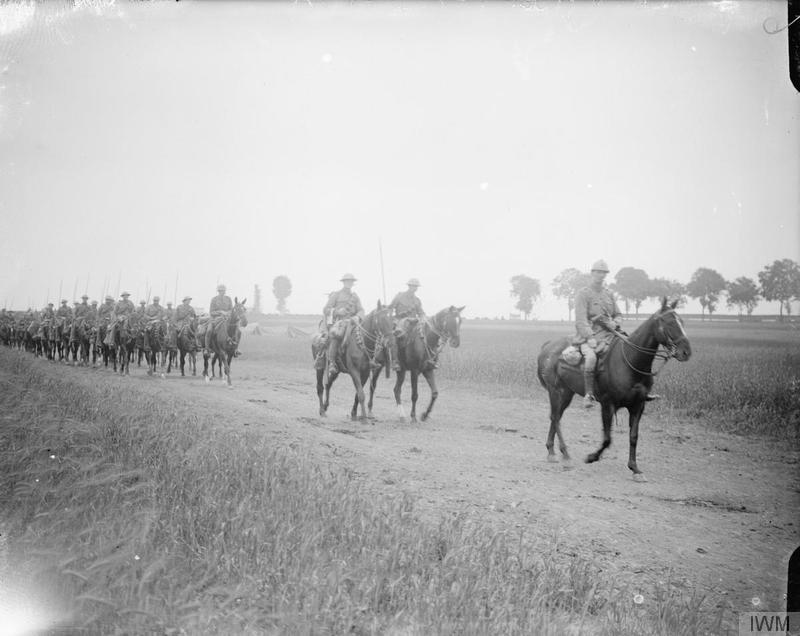
©IWM (Q 4054)
Meanwhile, on 4th July 1916, 63 men were detailed from 9th Lancers as part of a larger party of 600 from 1st Cavalry Division, to assist in clearing the battlefield at Fricourt, leaving at dawn and returning at 6.30pm. This was one of several such parties provided during the next few months by the cavalry, described by one officer (and quoted in the Regimental History) as a "Vulture Party". They removed wounded, buried the dead, salvaged useable equipment (such as the rifles of dead and wounded men) and cleared debris - a far cry from the glory and romance of a cavalry charge, but seemingly, of more value in the circumstances.
The following day, 5th July, 53 men, led by two officers, went to the XIII Corps area "for work" (as the War Diary describes it), while the remainder of the regiment withdrew to Warlus, sixteen miles west of Amiens. According to the 9th Lancers War Diary, this working party spent nearly a month behind the front line, being relieved on 3rd August. From 16th July, they were led by Second Lt Martin Hunter, who wrote about the work in his diary (quoted in the Regimental History). Although the work was behind the fighting, it was far from "safe":
It is by no means an easy party we have got on ... Old Fritz would not leave us alone, he kept on sending over "coalboxes" and high-explosive and shrapnel all night. About the middle of the night we got tear shells and gas...
Stayed up all night ... hell of a night, no cover in trench, no rations, six casualties, one gassed" (this appears to refer to the night of August 2nd, when the War Diary refers to five men wounded, one of whom died).
Shelled most of the night, and gas attack.
Things got a bit too hot; one 5.9 [shell] landed about twenty yards from us and covered us all with mud, so we moved into dugout. Rats awful!
On 24th July, another working party, consisting of two officers and 67 other ranks, was sent to the Fricourt area for the same purpose. The War Diary records that they were partly relieved on 21st August, by a further party of 51 other ranks. Yet another party, of 51 other ranks, was sent to the "forward area" on 8th October. Both men and officers were rotated through the role, until the dismounted party finally rejoined the regiment on 21st October.
Death
It appears that Charley was amongst those members of 9th Lancers detailed for the "Vulture Parties" - either on 24th July, or on 21st August. On 15th September, the 9th Lancers War Diary records that "Major A M Grenfell was wounded with the Divisional working party"; and in the margin alongside, apparently at the same time, "1 OR killed and 5 OR wounded in action".
Subsequently, Major Grenfell was awarded the DSO for "conspicuous gallantry" in the action in which he was wounded. The citation (London Gazette 20th October 1916) read:
He rallied a considerable number of men who were retiring, and with some of his own working party, led them forward and consolidated a position under heavy rifle and machine-gun fire. Later, while trying to get a wounded officer back to safety, he was himself wounded.
Awarded a Military Cross was Lt W G Gisborne (London Gazette 20th October 1916):
He assisted his senior officer in rallying a number of infantry, who had lost their officers and were retiring. They led them forward and consolidated a position under fire. Later, when his senior officer was wounded, he brought him in under heavy rifle and machine gun fire.
The 9th Lancers nominal roll confirms that Charley was killed in action on 15th September 1916, and that Major A M Grenfell was wounded on the same day. Taken together with the War Diary, this indicates that Charley was a member of the Divisional Working Party.
The 9th Lancers War Diary records the awards to Major Grenfell and Lt Gisborne on 28th September, but does not provide any further details of the action for which they were awarded, and in which, it seems, Charley was killed. The above accounts suggest that the Divisional Working Party, under Major Grenfell, was involved in rather more than battlefield clearance on 15th September, which was the opening day of the offensive intended to capture the original German Third Line defensive system. More research is required on this point.
Commemoration
Charley is one of 72,000 men commemorated on the Thiepval Memorial, the Memorial to the Missing on the Somme, for those dying in the Somme sector before 20th March 1918, and who have no known grave.

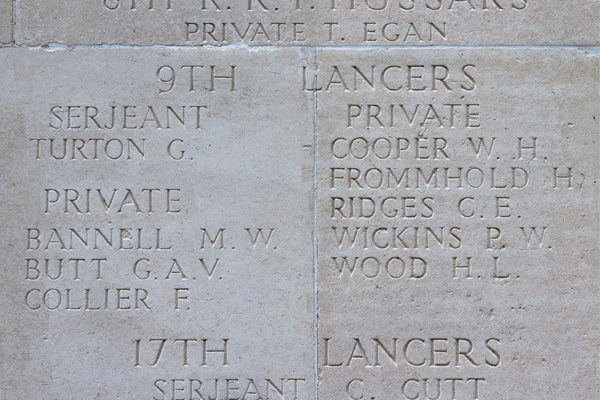
In Dartmouth he is commemorated on the Town War Memorial and the St Saviour's Memorial Board.
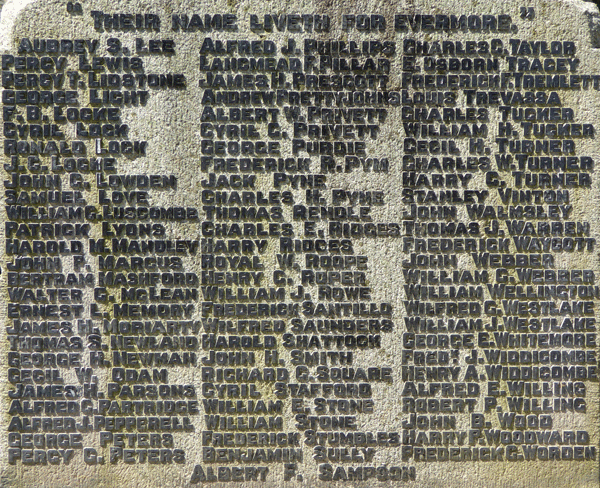
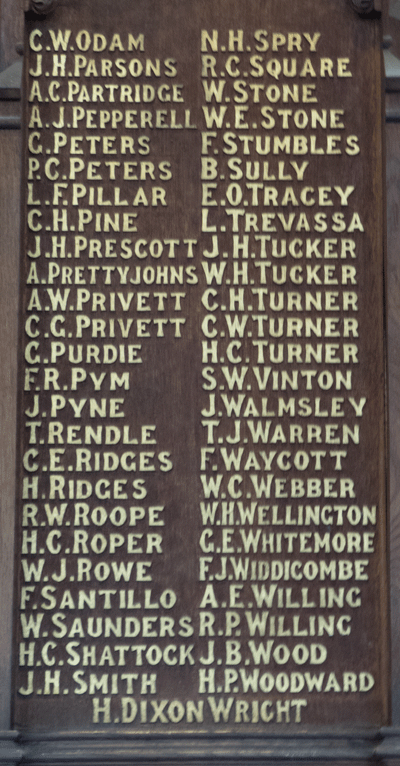
He is also commemorated in the inscription on his brother Harry's grave in Longcross Cemetery:
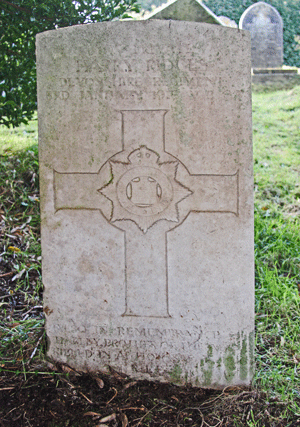

Charley is also commemorated on the 9th Lancers War Memorial in Canterbury Cathedral.
Sources
War Diary of 9th (Queen's Royal) Lancers available for download from The National Archives, fee payable, reference WO 95/1113/2
The nominal roll of the 9th Lancers during the First World War may be searched on the website of the 9th/12th Royal Lancers Museum
The museum's website also provides access to a digitised copy of the Regimental History: The 9th Queen's Royal Lancers 1715-1936, by Major E W Sheppard, pub Gale and Polden Ltd 1936
9th Lancers War Memorial, Canterbury Cathedral
A History of the British Cavalry 1816-1919, volumes 7 and 8, by The Marquess of Anglesey FSA, pub 2013 and 2012 respectively, Pen & Sword Books
Doctrine and Reform in the British Cavalry 1880-1918, by Stephen Badsey, publ 2008, Ashgate
See also this article about another member of the 9th Lancers "Vulture Party", the writer's grandfather
Information Held on Database
| Surname: | Ridges |
| Forenames: | Charles Edward |
| Rank: | Private |
| Service Number: | 4585 |
| Military Unit: | 9th (Queens Royal) Lancers |
| Date of Death: | 15 Sep 1916 |
| Age at Death: | 22 |
| Cause of Death: | Killed in action |
| Action Resulting in Death: | Battle of the Somme |
| Place of Death: | Unknown (see story) |
| Place of Burial: | Commemorated Thiepval Memorial, France |
| Born or Lived in Dartmouth? | Yes |
| On Dartmouth War Memorial? | Yes |
| On St Saviour's Memorials? | Yes |
| On St Petrox Memorials? | No |
| On Flavel Church Memorials? | No |
| In Longcross Cemetery? | No |
| In St Clement's Churchyard? | No |
| On a Private Memorial? | No |
| On Another Memorial? | Yes |
| Name of Other Memorial: | 9th Lancers Memorial, Canterbury Cathedral |















